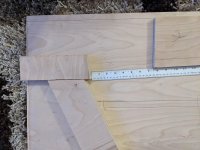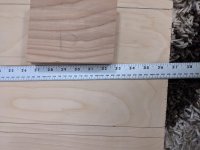I just priced out the parts to build a PM90 and it's just not in my budget. lol. circling back to the SynTripP again. building the thing just seems daunting.
@ Singtall
I also found the thought of building the SyntripPs quite daunting however with the availability of quality 3d printers and CnC machines these days it is definitely doable with minimal woodworking experience. I used Jenny Girls design files for the cone filler plugs and throat adapter which have been working quite well. I also had the outline of the main sections of the horn cut with a CNC machine and then used a sacrificial fence to cut the miders afterwards. There were definitely some frustrating moments but at the end of the day it wasn't as hard as I expected it to be and the reward was definitely worth the troubles! The quality of sound that the SyntripPs put out is truly remarkable!
I also found the thought of building the SyntripPs quite daunting however with the availability of quality 3d printers and CnC machines these days it is definitely doable with minimal woodworking experience. I used Jenny Girls design files for the cone filler plugs and throat adapter which have been working quite well. I also had the outline of the main sections of the horn cut with a CNC machine and then used a sacrificial fence to cut the miders afterwards. There were definitely some frustrating moments but at the end of the day it wasn't as hard as I expected it to be and the reward was definitely worth the troubles! The quality of sound that the SyntripPs put out is truly remarkable!
Last edited:
I just cut some boards for my first Keystone subwoofer! I'm working it old school with no table saw, just cordless handsaw. taking my time getting the boards cut square and perfect as possible. I just realized that I have no way to measure the exact angles specified so back to home depot I go to get more tools and a little more wood. Somehow I thought someone said it takes a sheet and a half per cabinet so I only bought 3 sheets for 4 cabinets. after looking at the drawing I need another sheet. lol.
You should be able to calculate angles from drawings somehow... not that i know how but google will tell you(I do like my angle finder tool). These boxs are pretty simple to build and you should still be able to have an excelent outcome with out flash tools. Best of luck.
I was thinking that I could draw out the horn section landing spots on one of the sides then predrill holes where i will need them. i can then use that side board as a template to drill the other side so that the screw holes will end up where I need them.
I just ordered a pair of 18tbw100-4's and a DBX Driverack PA2. I was thinking that I would start with two of these and pair it with two SynTripP tops. I'm hoping the subs will keep up. worse case I build 2 more Keystones. anyone try the combo with only 2 subs?
@Sintall
That is pretty much my exact set-up. Two Keystones loaded with 18TBW-100 powered by an NX-6000/Driverack PA2. I have found that for house and techno two keystones is just enough to keep up with the SyntripPs when used outside. For dubstep or drum and bass music with long rolling basslines two more keystones would be nice but not totally necessary.
That is pretty much my exact set-up. Two Keystones loaded with 18TBW-100 powered by an NX-6000/Driverack PA2. I have found that for house and techno two keystones is just enough to keep up with the SyntripPs when used outside. For dubstep or drum and bass music with long rolling basslines two more keystones would be nice but not totally necessary.
How much does it effect the low end if I mount rubber feet on the bottom of the cabinet? How about casters?
Where do I put the pole mount? Does that tube going into the cabinet effect it much?
Where do I put the pole mount? Does that tube going into the cabinet effect it much?
I bought the 4ohm versions and I'm looking for amp suggestions. Probably going to keep it fairly cheap by going with something like Behringer but I want to make sure I get the right amp model to pair up with these two four ohm speakers. Already have an inuke3000 in stock that can be used either with these cabinets or the tops.
Singtall,
The NU3000 bridged mono into 4 ohms does 3000 watts, plenty of peak power for the BC18TBW100-4. Getting a second would allow for backup if one failed.
Rubber feet will have no effect on the low end of the cabinet.
Casters usually rattle, better to use detachable casterboards that fit the foot pattern, though on bumpy conditions or carpet, a two wheel dolly with large pneumatic works better.
A pole mount "top hat" could be mounted on the top or side (or both) with almost no adverse sonic affect. Brace placement would need to be adjusted for top mount.
Art
The NU3000 bridged mono into 4 ohms does 3000 watts, plenty of peak power for the BC18TBW100-4. Getting a second would allow for backup if one failed.
Rubber feet will have no effect on the low end of the cabinet.
Casters usually rattle, better to use detachable casterboards that fit the foot pattern, though on bumpy conditions or carpet, a two wheel dolly with large pneumatic works better.
A pole mount "top hat" could be mounted on the top or side (or both) with almost no adverse sonic affect. Brace placement would need to be adjusted for top mount.
Art
thanks for the reply Art. I appreciate your input.
would casters on the bottom of the cabinet instead of rubber feet be a problem?
I was looking at the pics posted in post 1331 and I saw that he had a pair of Syntrips mounted on poles into the Keystones. so I thought that might be perfect for me to do also. just didn't know if it would affect the sound or can I put the mount further back of the cabinet (when top mounted) to avoid hitting the braces? I don't want to introduce delay/phase issues when I put the top cabinet on.
would casters on the bottom of the cabinet instead of rubber feet be a problem?
I was looking at the pics posted in post 1331 and I saw that he had a pair of Syntrips mounted on poles into the Keystones. so I thought that might be perfect for me to do also. just didn't know if it would affect the sound or can I put the mount further back of the cabinet (when top mounted) to avoid hitting the braces? I don't want to introduce delay/phase issues when I put the top cabinet on.
I'd consider using the M20 style pole mounts. I used the top hat style at first and had issues with the pole swaying both from wind and sub vibration. Also the M20 style are very shallow in comparison so you wont have issues with brace interference.
https://www.amazon.com/gp/product/B00FKY86V6/ref=ppx_yo_dt_b_asin_title_o08_s01?ie=UTF8&psc=1
https://www.amazon.com/gp/product/B00FKY86V6/ref=ppx_yo_dt_b_asin_title_o08_s01?ie=UTF8&psc=1
Yes to M20 threaded top hat!! - I occasionally use long extension poles so I fitted metal plates on the inside of the cabinet that clamp to the top hat through the ply - Very rigid
Just using penny washers wont cut it with a long pole. And yes the center brace was trickier to fit but well worth the effort.
Cheers
Martin
Just using penny washers wont cut it with a long pole. And yes the center brace was trickier to fit but well worth the effort.
Cheers
Martin
I ordered these before I heard back from anyone. hmmm, i wonder if they will work?
Penn Elcom M1555 Steel Speaker Mounting Top Hat for 1-3/8" Tripod Stand
https://www.amazon.com/gp/product/B005D7SXD6/ref=ppx_yo_dt_b_asin_title_o00_s00?ie=UTF8&psc=1
Penn Elcom M1555 Steel Speaker Mounting Top Hat for 1-3/8" Tripod Stand
https://www.amazon.com/gp/product/B005D7SXD6/ref=ppx_yo_dt_b_asin_title_o00_s00?ie=UTF8&psc=1
I just ordered the recommended mounts. I guess I can use the other ones for the top cabinets.
would casters on the bottom of the cabinet instead of rubber feet be a problem?
I didn't know if I would be losing some low end by not having the cabinets touching the floor.
I didn't know if I would be losing some low end by not having the cabinets touching the floor.
I cut everything according to the plans and the M boards look too long. Trying to work that out now.
Attachments
Last edited:
Casters on the bottom of a cabinet used as a base for a supported speaker are unsafe. Wind loads or crowd bumps will rotate the casters inward, reducing the base size considerably.
At only 22.5" x 26" base size, I would not advise using the Keystone sub with a pole mounted speaker above unless attached to a plinth (platform) with a ratchet strap.
The plinths in the photo below are 45" x 45", the cabinets the same base size as the Keystone.
Two layers of 10mm (.357") LP SmartSide panel siding material laminated together work great for plinth material, very strong, and rot and insect proof.
At only 22.5" x 26" base size, I would not advise using the Keystone sub with a pole mounted speaker above unless attached to a plinth (platform) with a ratchet strap.
The plinths in the photo below are 45" x 45", the cabinets the same base size as the Keystone.
Two layers of 10mm (.357") LP SmartSide panel siding material laminated together work great for plinth material, very strong, and rot and insect proof.
Attachments
- Home
- Loudspeakers
- Subwoofers
- Keystone Sub Using 18, 15, & 12 Inch Speakers



